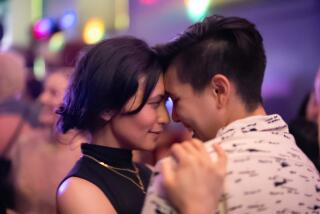Taking a look at gay history
- Share via
They read like dispatches from the controversy over Proposition 8, the current ballot initiative that would ban marriage between same-sex couples in California.
“Homosexual Marriage?” asks one magazine headline in large white type. Another takes a more aggressive approach: “Let’s Push Homophile Marriage,” accompanied by an illustration of muscled men in amorous poses.
But a closer look at these magazine covers reveals something rather unexpected. They were published in 1953 and 1963, respectively -- decades before same-sex marriage became a national lightning rod, let alone a rallying point for gay rights activists.
Copies of these yellowing periodicals were scheduled to go on display Saturday at the ONE Archives Gallery and Museum, a new space in West Hollywood that appears to be the first museum in Southern California solely dedicated to gay history.
The museum -- really a micro-museum at 600 square feet -- has set a macro goal for itself: to bring little-known aspects of gay history out of the library closet and into the public sphere. The museum is an offshoot of the ONE National Gay and Lesbian Archives, which is affiliated with USC. The old magazine covers dedicated to gay marriage come from ONE magazine, the first gay publication in the country.
“They show that we’ve been having this fight for a very long time, longer than most people think,” said Joseph Hawkins, president of ONE. “It was an act of defiance to publish stuff like that in the ‘50s and ‘60s. I’m surprised that alone didn’t get the magazine shut down.”
Hawkins, a professor of anthropology and gender studies at USC, serves as curator of the museum. Because the archives are a 501(c)(3) not-for-profit organization, the museum by extension cannot directly support political causes, including the effort to defeat Proposition 8. “Let’s just say we have to be extremely careful,” Hawkins said.
The city of West Hollywood donated the space -- a former storage garage off Robertson Boulevard -- to the museum and is helping with some of the costs. The rest of the funding comes from the ONE Archives.
For the opening, the museum plans an exhibit that covers the history of the Christopher Street West parade -- the gay pride celebration that makes its way down Santa Monica Boulevard each year.
Among the parade-related documents on view are several newspaper articles, including stories from the Los Angeles Times. One Times headline dating from June 29, 1970, reads “Homosexuals Stage Hollywood Parade,” followed by “Event evokes boos and catcalls but no violence.”
Robert Nunez, a board member of ONE, views the museum as “an espresso shot of the gay community’s history. Gay pride has come to mean parades and carnivals. This is a different approach.”
He said his favorite artifact in the museum is a 1975 letter from Los Angeles Police Chief Ed Davis declining an invitation to participate in the gay pride march.
The letter reads: “I would much rather celebrate Gay Conversion Week, which I will gladly sponsor when the medical practitioners in this country find a way to convert gays to heterosexuals.” (Later, as a Republican state senator, Davis denounced the religious wing of his party and voted for a gay-protection bill.)
Future exhibitions for the museum are in the planning phase, but they will draw almost exclusively from the ONE Archives. Potential shows will spotlight the organization’s legal activities. In 1950, ONE helped argue a case involving William Dale Jennings, who was arrested by the LAPD in Griffith Park for indecent behavior.
In the 1950s, the LAPD would hire B-movie actors to pose as gay men cruising public restrooms and arrest anyone who responded. ONE helped argue Jennings’ case against entrapment and won. (Jennings would go on to co-found ONE magazine.)
Interest in gay history isn’t limited just to the gay community.
According to Paul Bone- berg, executive director of the GLBT Historical Society in San Francisco, heterosexuals make up a growing number of tourists to gay cultural venues.
“Gay and lesbian history is more appreciated by the larger American culture than ever before,” Boneberg said.
“Someone like Harvey Milk isn’t just a gay hero; he’s an American hero,” Bone- berg said.
San Francisco’s GLBT Historical Society is scheduled to open its own art-historical space in the Castro in early November, to coincide with the premiere of the Gus Van Sant film “Milk.” The society estimates 20% to 30% of visitors will be heterosexual.
Striking a balance between the mainstream and the more risque, sexually charged exhibits will prove challenging for museums.
West Hollywood’s ONE Archives Galley and Museum will attempt to attract young gay visitors by mixing history and sex, with upcoming shows such as “Lesbian Pulp Fiction” and “Male Nudes and the Bodybuilder in Los Angeles.”
It also plans to rotate the three-month historical exhibitions with contemporary art shows.
“We’ve always been a bookish institution,” Hawkins said. “This is our effort to become sexier and to attract visitors who wouldn’t normally be interested in visiting a historical institution.”
--
More to Read
The biggest entertainment stories
Get our big stories about Hollywood, film, television, music, arts, culture and more right in your inbox as soon as they publish.
You may occasionally receive promotional content from the Los Angeles Times.











